| Because there wasn't a direct flight to go home, we flew from Kraków and were thus given the chance to visit this wonderful European capital. Here are a few facts related to our project: |
GENERAL HISTORY |
| |
| Kraków is the second largest and oldest city in Poland. It is situated on the Vistula River. |
In the year 1000, an archbishopric was created, and the city became the capital of the kingdom of the dynasty Piast. At the same time, the first Roman castles and churches were set up on the Wawel hill. A school and a library were opened, making Kraków an intellectual life centre in Poland. The Wawel was then the centre of the city. Rich and powerful, Kraków constituted a tempting target for the Mongolian looters who invaded it in 1241, leaving it in ruin. During its reconstruction, the centre moved north. To prevent new attacks, defensive bulwarks and watchtowers were set up around the city which prospered. In 1364, King Casmir III the Great established the academy of Kraków, which was then the second university of Central Europe after Prague's. |
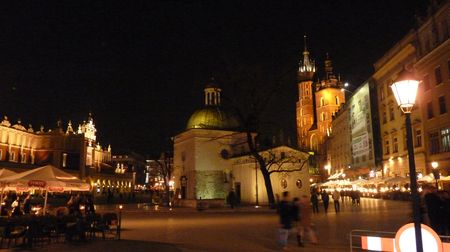
Kraków by night
|
| |
|
| The dynastic alliance of Poland with Lithuania marked the beginning of a golden age in the domains of culture and knowledge. Kraków became a member of the Hanseatic League, which is the association of the trade cities of Northern Europe around the North Sea and around the Baltic Sea. This Hanse distinguished itself from the other Hanses and traders because its business was based on privileges which had been granted to them by diverse European sovereigns. At this time, artists and famous Italian architects took care of the ornamentation of the castle of Wawel. The university attracted numerous brilliant spirits of that period. Its most famous student was Nicolas Copernic. At that time the population exceeded the number of 30 000 inhabitants. In 1596, King Sigismund Vasa III transferred the capital to Warsaw privileging its more central location. |
| |
| Having known neither big battles nor bombardments during the Second World War, Kraków is practically the only Polish city to have preserved its ancient architecture. However, its inhabitants did not escape the hands of the Nazis, and many Jews were gathered in the ghetto of Podgorze where they made hard labour. They were then deported towards the Nazi extermination camps. The ghetto was totally destroyed in 1943, taking 65 000 lives with it. We can still visit Schindler enamel factory where Oskar Schindler employed thousands of Jewish prisoners, saving most of them from a certain death. The factory became a museum in 2009. |
| |
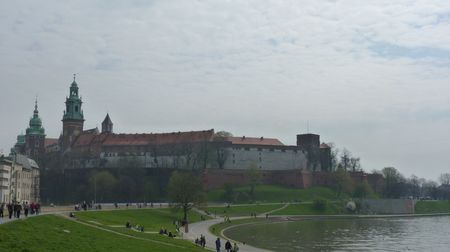 |
| Wawel Hill |
| |
| Poland was freed by the troops of the Red Army in the spring of 1945. During the conference of Yalta, Roosevelt, Churchill and Stalin decided to leave the country under Soviet control: the leaders of the resistance were accused of collaboration with the Nazis and executed, and the Polish United Workers' Party took the head of the government. In 1978, the archbishop of Kraków, Karol Wojtyla, became the first Polish Pope under the name of John-Paul II. According to an investigation of a Polish newspaper, 73 % of the Poles consider he played a major part in of the liberation of Poland in 1989. |
| |
| Since the collapse of the communism in 1989, the young Polish democracy has been confronted with political instability. However, it does not prevent it from forging ahead proudly. Poland joined NATO in 1999 and the European Union in 2004. |
| |
| WAWEL CASTLE AND CATHEDRAL |
| |
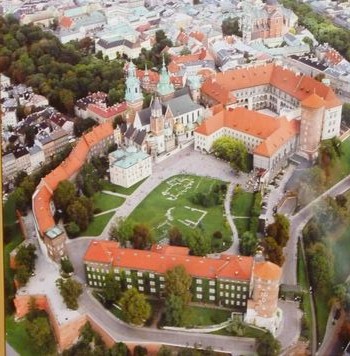 |
| The Castle and Cathedral of Kraków |
| |
| Located to the south of Kraków old town, Wawel Hill is a limestone rock that rises 25 meters above the Vistula River. The wetland terrain which originally surrounded the hill made it a natural defensive position. |
| |
| Visitors can see the Wawel Castle, the Cathedral, the Bell Tower, and of course the infamous Dragon's Lair. |
| |
| THE CASTLE |
| |
| Wawel Kraków is one of the most popular tourist attractions in the area. The land, which is home to this royal castle in Poland, has a history dating back as far as 50 thousand years when many people lived on Wawel Hill. During the 16th century, King Sigismund First the Old brought in Italian architects, Italian sculptors, and German decorators to create this castle. Wawel Castle soon became the model for other Polish castles throughout the area. |
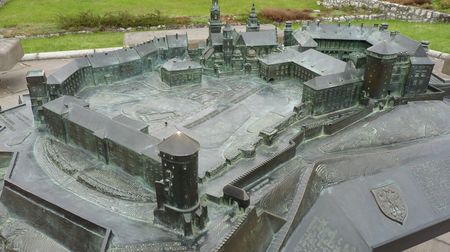 |
| |
The Castle and Cathedral of Kraków |
| |
| The surface locked into the walls of the castle equals almost that of the Big Square. Inside this three-storied castle, we can find major exhibits: the Crown Treasury, the Armoury, the Private Apartements and the magnificent Royal State Apartments, with a collection of oriental art and war trophies, magnificent tapestries of Flanders and the archaeological testimonies of the Christian presence on the Polish territory which date more than 1000 years. |
| |
 |
| The Students of the Comenius Project |
| |
| THE CATHEDRAL |
| |
The SS Wenceslas and Stanislaus Cathedral in Kraków is one of the most noble of Polish churches. The current Gothic cathedral began in 1320 and was consecrated in 1364.
|
| |
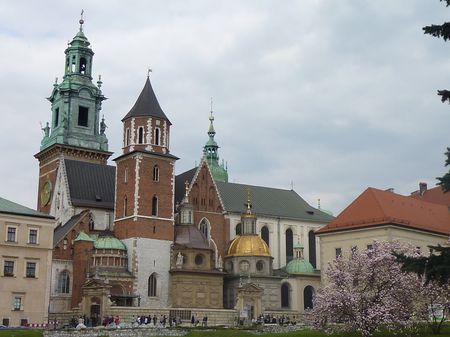 |
| The Cathedral of Kraków |
| |
| The coronation site of Polish monarchs and their eternal resting place, the pantheon which houses the ashes of Polish national heroes and the sanctuary of the Polish patron St Stanislaus, the cathedral is also a treasury of national mementos and a work of art. It has been the witness to the most important state and religious event. It houses the enormous "Sigismund" bell which resounds only on very important occasions. |
| |
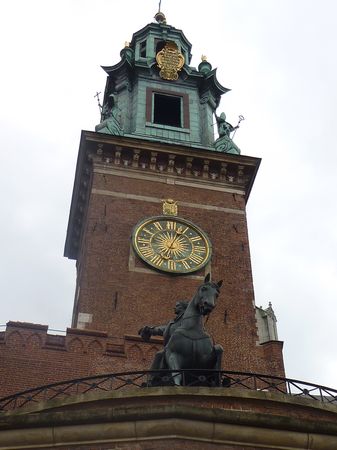 |
| The Cathedral of Kraków |
| |
| As you head toward the Cathedral up Wawel Hill, you may notice the bones that are chained to the wall. |
| |
| THE BONES OVER THE CATHEDRAL GATE |
| |
| The legend says that thousands of years ago, before man became the master of the earth it had been inhabited by a race of giants. It cannot be said today what they looked like, but one can suppose that they led lives similarly to us, trying to understand the mystery of existence and seeking love and happiness. They also got very much used to their dwelling places and if circumstances forced them to leave and go far away they would always come back to their native land at the end of their lives. One such giant was buried near Wawel Hill. |
| |
| For centuries the bones of these large creatures lay decomposing in the ground and therefore only very few of them were later able to be dug out by people. But whenever some of them were found they were treasured as precious amulets which would protect their owners from all sorts of evil. Thus the inhabitants of Kraków were overjoyed when three mighty and well preserved bones of a giant were dug out by chance near Wawel Castle. |
| |
| One wise astrologer read in the stars that it was a very good omen. That's why the bones was suspended near the entrance to the cathedral. |
| |
| SMOCZA JAMA'S CAVE |
| |
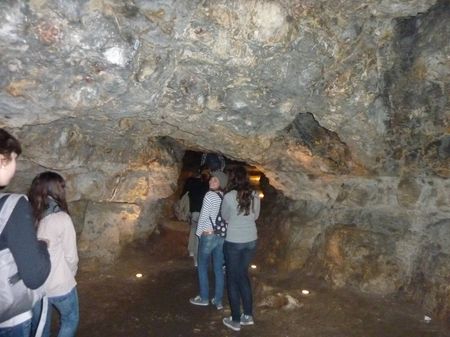 |
| Smocza Jama's cave |
| |
| Smocza Jama's cave has two entrances: a natural one, facing the Vistula River and an artificial one, dating from the XIXth century, drilled for water supply. In 1974, a third access was discovered leading to the Basilica-cathedral Saints-Stanislas-et-Venceslas of Kraków. |
| |
| This cave is 276 meters long and 15 meters high. It was first mentioned in the XIIIth century by the bishop of Kraków, Vincent Kadlubek. He told the legend of the Wawel dragon dwelling in this cave and terrorizing the neighbourhood. There is a commemorative tablet in honour of the legendary prince Krakus who overcame the dragon and gave his name to the city. It says: "Here is the cave in which having killed the wild dragon, he settled at Wawel, and founded the city of Kraków." |
| |
| THE WAWEL DRAGON |
| |
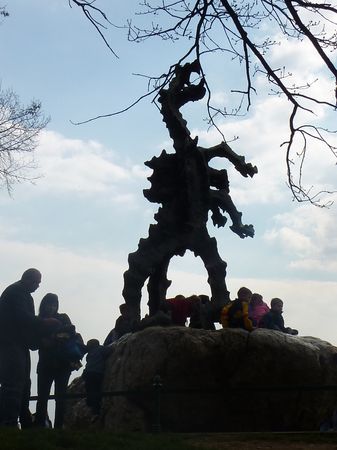 |
The Wawel Dragon also known as the Dragon of Wawel Hill or simply called Smok, is a famous dragon in Polish folklore. According to the legend, this animal lived in a cave of limestone, called in Polish "Smocza Jama" (in English "the Lair of the Dragon"), situated inside the cliff on which rises the city of Wawel, overhanging the Vistula. |
| |
| A popular version of the Wawel-dragon tale takes place in Kraków. Each day, the evil dragon would beat a path of destruction across the countryside, killing the civilians, pillaging their homes and devouring their livestock. In many versions of the story, the dragon especially enjoyed eating young maidens, and could only be appeased if the townsfolk left a young girl in front of its cave once a month. King Krakus wanted to finish it with this dragon, so, he asked the bravest of the knights of his kingdom to come and confront with the animal. They were all defeated and lost their lives because of the breath of fire coming out of the mouth of the animal. |
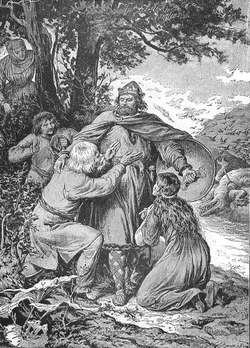 |
| 1970's metal sculpture of the Wawel Dragon designed by Bonislav Chromy |
|
| |
As a last resort, the king promised the hand of Wanda, his beautiful daughter to whom could defeat the dragon. The bravest of the warriors fought against the animal again but nobody manages to overcome the dragon. One day, a poor apprentice shoemaker, named Szewczyk Dratewka, accepted the challenge.
|
| |
| He stuck a lamb with some sulphur and put it outside the cave of the dragon. The latter was attracted by the smell of the animal and ate it. A short time later it was enormously thirsty because of the sulphur. It went to the Vistula River and drank ceaselessly. Yet its stomach was not soothed from the pain which tormented it. It continued to drink and its stomach swelled enormously as it emptied waters of the Vistula. The dragon finally exploded. Szewczyk Dratewka married the king's daughter as betrothed and they lived happy ever after. |
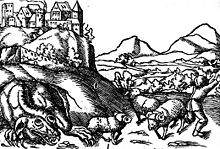 |
| |
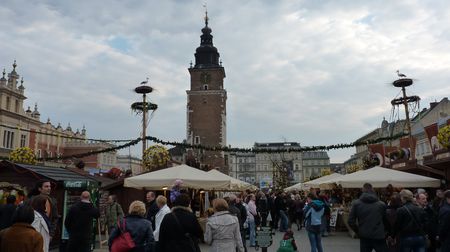 |
 |
| Celebration of Palm Sunday in the Square |
 |
| Entertainment in the Main Market Square of Kraków |
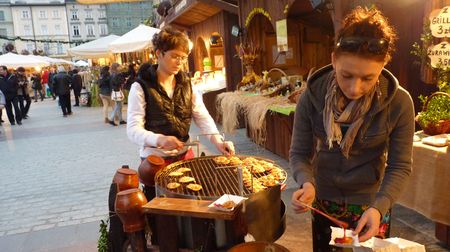 |
| Traditional Polish food |